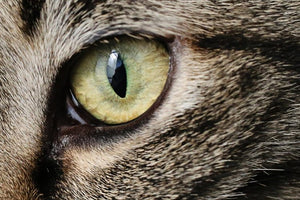The eyes of your feline friends have often been used on horror films. But if you are a pet owner, you will know that the cat's stare is really the opposite of what's being portrayed on films. That is why you have to know the importance of cat eye care.
I Love You
How do cats say these words? Through their eyes, of course. That is why you shouldn't be frightened by that gaze. How does this work? First, the cat stares at you for a long while. And after that, it blinks its eyes slowly. Some people tag this as a cat's kiss. But you can also say that this is your cat's way of saying that it loves you.
But how do you return the favor? Easy, just follow your cat's lead. Stare at it for a long time and then slowly blink your eyes. See? Cats' eyes can also be used as elements for romantic films.
Not a Third Eye
Don't believe the horror films you see. Cats don't have a third eye. Their eyesight is really sharper than with humans. Instead of a third eye, what cats have is a third eyelid. This is called a nictitating membrane.
This inner eyelid protects the eyes of the cats from harm and also from dryness. You will notice that when a cat is sick, this membrane will somewhat close. This should alarm you to call the vet or get your cat to them fast.
But this third eyelid will also show once a cat is happy. So you will know what mood your cat is in just by looking at the membrane.
The Pupil
Your feline friend's pupil of the eyes should also be observed. A change in size of one pupil can be an indication of an inflammation. It can also be a sign of a kind of a disorder in neurologic called Horner's Syndrome. Or worse, it can also indicate tumors or injuries in the central nervous system.
The Nocturnal Vision
Do not believe what others say that cats are color blind. They see some. They may not see as clear as humans do, but it's not like that they cannot see any colors at all.
Cats can also see clearly from afar. It's very different from people. They find it blurry to be looking at things that are so close to them.
Yes, cats have the nocturnal vision. But they can't see in complete darkness. Do you see the muscles on their iris that surround the pupils of their eyes? They are constructed in a way that it narrows into a vertical split when they are exposed in the bright lights. And it opens fully when the acts are in a quite dim light.
This feature of the cats may be traced back to their roots. They can use such to hunt for food during the night if they were left out in the jungle or left with no one to care for them.
So forget about the horror flicks. You've already got the thrills. Not it's time to put some effort into cat eye care. Do not let a minor thing worsen. Call the vet immediately when something's amiss. You don't want your cat to lose their sight or even lose their lives. It is always better to be safe than blind.

Common cat eye problems
We’ve outlined some of the most common eye conditions found in cats. If you’re ever concerned about your cat’s eyes, it’s always best to seek the advice of your vet as soon as possible.
Conjunctivitis
Also known as pink eye, this condition creates inflammation over the inner eyelid or outer layers of the eye. It’s one of the most common eye problems for cats and is often caused by viral infection, although it can also be caused by bacteria, allergens and foreign bodies.
Symptoms
- Redness
- Swelling
- Discharge
- Squinting
- Irritation and pawing at the eyes
Treatment
The treatment your vet recommends will depend on what caused your cat’s conjunctivitis. If your cat’s conjunctivitis is bacterial, your vet may prescribe antibiotics that may be topical, oral or both. For viral infections, antiviral medications are sometimes recommended, but vaccinations can also protect against future infections. Allergic conjunctivitis may be treated with an eye wash or ‘anti-allergy’ medications. Steroidal treatments may also be recommended.
Corneal ulcers
If your cat’s cornea becomes scratched, this can develop into a painful ulcer. Often these ulcers are caused by a laceration from a scratch to the eye, or a foreign body like a grass seed. Corneal ulcers can be difficult to detect, but can rapidly progress.
Symptoms
- Watery eyes
- Excessive discharge
- Blinking more than usual
- Redness
- Pawing at the eye
Treatment
Your vet may use a special stain to detect a corneal ulcer. The treatment will depend on what caused the ulcer, but can include topical antibiotics and anti-inflammatories. Sometimes, surgery will be necessary to debride the cornea and promote healing.
Cataracts
Cataracts can be an inherited condition. Some breeds, including Birman, Persian and Himalayan cats, are predisposed to developing cataracts. Older cats, or those with diabetes, are also more at risk. Other reasons for developing feline cataracts include trauma, inflammation and hypertension.
Symptoms
- Blue-grey cloudiness of the pupil
- Signs of reduced vision including bumping into objects, reluctance to explore and instability
Treatment
The severity of the cataract will determine treatment. Your vet may recommend removing the affected lens, which will reduce your pet’s ability to focus but improve their overall vision. This will require referral to a veterinary ophthalmologist. Cataracts are not painful, but you may need to take extra care of your cat if their vision is impaired.
Glaucoma
Glaucoma occurs when the fluid within the eye cannot drain as normal. As a result, there’s a build-up of pressure, which can cause your cat’s eye to become enlarged. Glaucoma is a condition that can develop as your cat ages. Left untreated, it can cause permanent damage to the optic nerve and retina, potentially resulting in loss of sight.
Symptoms
- Squinting or blinking
- Overly large or small pupils, that are unresponsive to light changes
- Redness
- Cloudiness
- Sticky discharge
- Signs of vision impairment, walking into objects or moving slowly
Treatment
Your vet may prescribe medication to lower the pressure within the eye or, in severe cases, removal of the eye may be necessary.
As independent creatures, cats are often very good at disguising any signs that they’re in pain. Take the time to check your cat’s eyes regularly, and ask your vet for advice if you spot any symptoms that give you cause for concern.
Recommended products
Beaphar Eye Lotion


